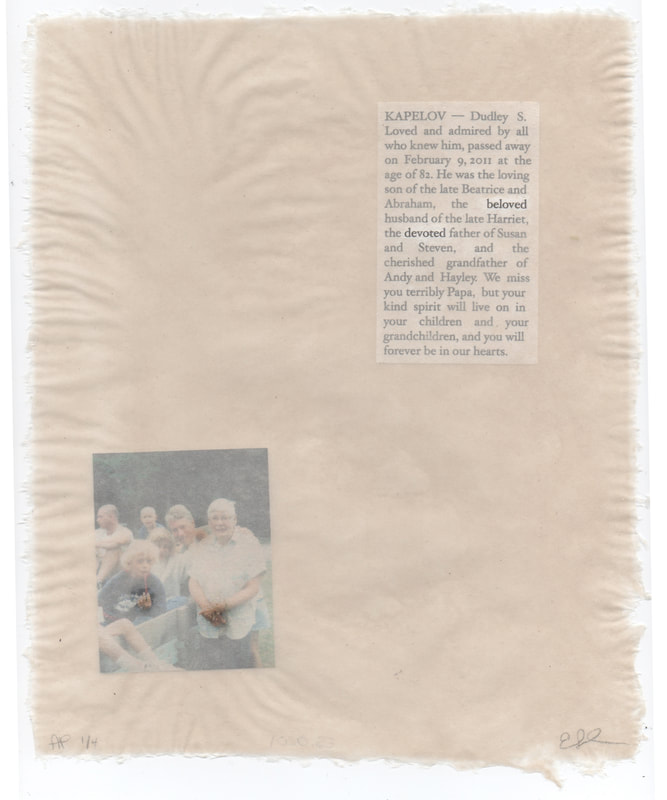Fragments, 2014
|
Inkjet prints embedded in abaca paper with fibers removed.
8 x 10 inches |
This piece was produced as an edition for the exchange portfolio titled Negative Spaces in Handmade Paper. You can see the exchange portfolio here.
The photograph I chose depicts a moment from a camping trip of which I have no direct memory. However, through stories and mementos, I have come to recreate details of the trip clearly. I am interested in the moment in our minds when the accuracy of memories becomes uncertain or irrelevant. The unveiling of portions of the image and text allows the viewer a clearer view into perceived recollection.
The text is appropriated from an obituary in the New York Times of a recently deceased father whom I have never met. For me, obituaries epitomize the glorification of the past and serve to immortalize that idealization—keeping one's memory alive and well. I find them particularly interesting because most of them use similar language, occasionally repeating exact phrases. This repetition brings up questions about the clarity and accuracy of reminiscence.
To make this piece, I beat abaca linters for four hours. I then inkjet printed the photograph and the obituary on commercial Asian paper. Once I laid the printed text and image on the abaca base sheet, I placed small pieces of mylar over select areas. I couched the top sheet and pulled off the abaca fibers that covered the mylar shapes and proceeded to extract them. This unveiling illuminates key words of the obituary and portions of the image, while the rest is left blurred beneath the surface.
The photograph I chose depicts a moment from a camping trip of which I have no direct memory. However, through stories and mementos, I have come to recreate details of the trip clearly. I am interested in the moment in our minds when the accuracy of memories becomes uncertain or irrelevant. The unveiling of portions of the image and text allows the viewer a clearer view into perceived recollection.
The text is appropriated from an obituary in the New York Times of a recently deceased father whom I have never met. For me, obituaries epitomize the glorification of the past and serve to immortalize that idealization—keeping one's memory alive and well. I find them particularly interesting because most of them use similar language, occasionally repeating exact phrases. This repetition brings up questions about the clarity and accuracy of reminiscence.
To make this piece, I beat abaca linters for four hours. I then inkjet printed the photograph and the obituary on commercial Asian paper. Once I laid the printed text and image on the abaca base sheet, I placed small pieces of mylar over select areas. I couched the top sheet and pulled off the abaca fibers that covered the mylar shapes and proceeded to extract them. This unveiling illuminates key words of the obituary and portions of the image, while the rest is left blurred beneath the surface.

